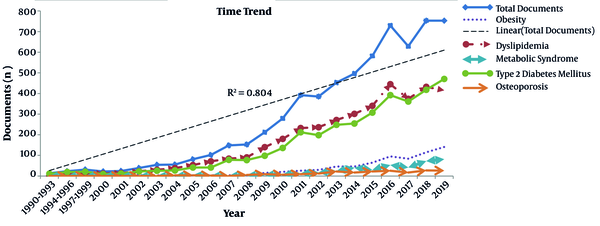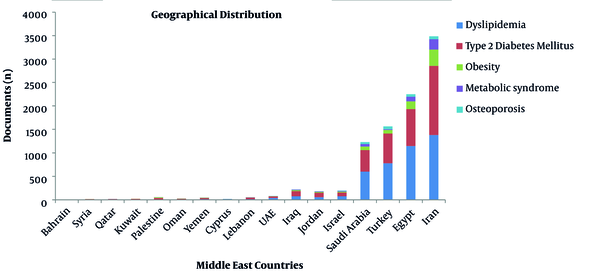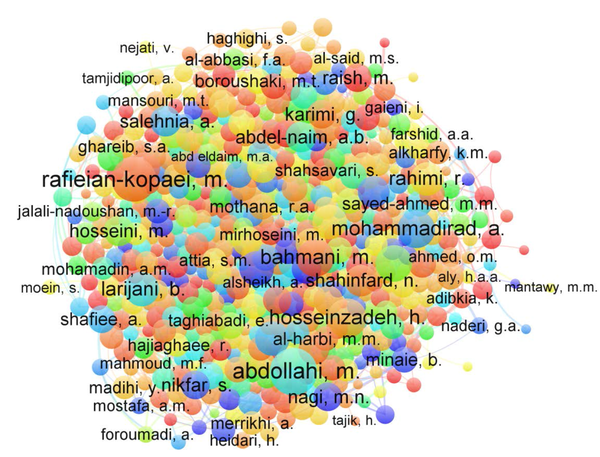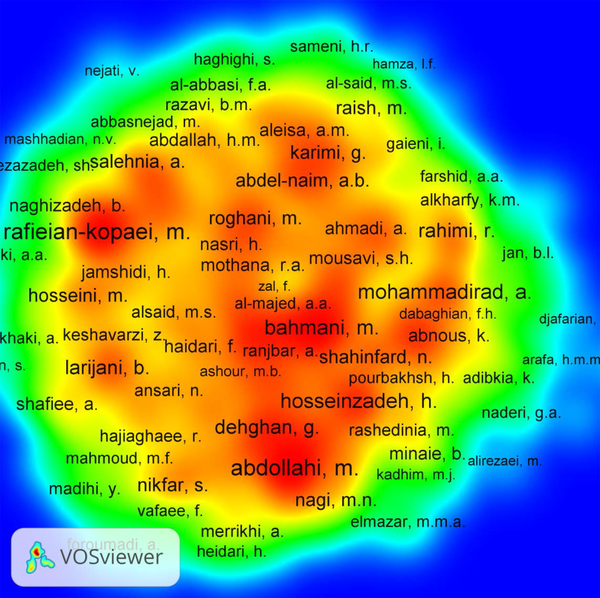Abstract
Context:
Prevalence of metabolic disorders, type 2 diabetes mellitus (T2DM), dyslipidemia, obesity, metabolic syndrome (MetS), and osteoporosis has been increased. Herbal medicine is an accessible, safe, and low-cost option in managing and caring for metabolic disorders. We conducted a bibliometric analysis of global scientific productions in herbal medications and metabolic disorders in the Middle East countries.Study Selection:
Our search terms were “diabetes”, “dyslipidemia”, “obesity”, “osteoporosis”, “metabolic syndrome”, “herb”, and “herbal medicine” in Middle East countries through the Scopus database until January 2020. We analyzed the data regarding publication year, main journal, geographical distribution, document type, subject area, co-authorship network, the h-index of citations by Scopus analysis tools, Visualizing Scientific Landscapes (VOSviewer) version 1.6.4, and SPSS version 15.Results:
Among 6408 global publications, most of the papers (> 85%) were original articles, and mostly (44.26%) were about dyslipidemia. A significant time-trend was shown in the number of documents (P < 0.001), mostly in 2019. Medicine and pharmacology were subject areas in > 80% of papers. The top country in the global publication number was Iran. The highest cited papers in dyslipidemia, obesity and osteoporosis were original articles from Turkey and Egypt, but in T2DM and MetS the highest cited paper was a review article from Iran. The top sources were “Phytotherapy Research” and “the Journal of Ethnopharmacology”. The top institutes were from Egypt, Iran, and Saudi Arabia and the principal author in the co-authorship network assessment was from Iran.Conclusions:
The time-trend growth in producing scholarly papers in the studied disorders is appreciated, but more evidence-based articles are still needed.Keywords
Bibliometrics Diabetes Mellitus Herbal Medicine Metabolic Syndrome Middle East
1. Context
The prevalence of non-communicable diseases (NCDs) and their related deaths is increasing worldwide due to aging and urbanization (1). Therefore, the World Health Organization (WHO) has introduced the NCDs Global Action Plan (25 by 25) for a 25 % reduction in premature deaths from NCDs by 2025 (2). Metabolic disorders including type 2 diabetes mellitus (T2DM), obesity, dyslipidemia, osteoporosis, and metabolic syndrome (MetS) are known to be highly prevalent non-communicable diseases (3).
Prevention and control of these NCDs require appropriate and effective interventional programs. Although many efforts have been performed to discover new synthetic drugs in recent years, uncomfortable adverse effects, high cost, and low accessibility have led scientists to consider alternative treatments such as herbal medicines (4, 5). In this way, the WHO has recommended assessing herbal medicines' efficacy in managing and treating human disorders (5). Scientific evidence has shown an acceleration in the popularity and usage of herbal medicines for metabolic diseases (6-9).
Bibliometric studies can reflect the trend of evidence-based scientific productions to help provide reliable evidence for policymakers (10). In this respect, the number of publications and their citations is substantial to note (10).
2. Objectives
To the best of our knowledge, no bibliometric study on traditional medicines was performed regarding metabolic disorders, T2DM, dyslipidemia, obesity, MetS, and osteoporosis in the Middle East countries. This paper aimed to assess the trend of published documents and their citations in this regard over the last 30 year years and to produce scientific evidence-based data for researchers and policymakers.
3. Study Selection
A descriptive bibliometric study on scholarly published articles covering 30 years of traditional herbal medicines’ research on metabolic disorders was conducted. Scopus was chosen due to its high multidisciplinary coverage and access to the citation numbers of papers (11). The search involved the published scientific papers in this regard from January 1, 1989, to January 1, 2020, affiliated to the Middle East countries. The alphabetical list of the Middle East countries included Bahrain, Cyprus, Egypt, Iraq, Iran, Israel, Jordan, Kuwait, Lebanon, Oman, Palestine, Qatar, Saudi Arabia, Syria, Turkey, United Arab Emirates, and Yemen (12). The search terms, including “herbal medicine” for “diabetes”, “hyperlipidemia”, “obesity”, “metabolic syndrome”, and “osteoporosis”, or their equivalents based on medical subject headings (MeSH) terms were used. The language was limited to English. Overall, the search strategy was (TITLE-ABS-KEY (plant AND disorder names)) AND AFFILCOUNTRY (country’s name) AND PUBYEAR>1988 AND PUBYEAR<2020 AND (LIMIT-TO (LANGUAGE, “English”).
4. Data Analysis
As a metric of research performance quality, the h-index of documents and the number of citations per paper were incorporated in data analysis (13). Other features of the collected data were publication year, main journal, the geographical distribution of publication (country), type of document, and the subject area searched from Scopus separately for each type of metabolic disorder. A subsequent analysis was then carried out using the “analyze search results” function of the Scopus database. Spearman’s test was used to determine the correlation between the numbers and years of publications. P-value ≤ 0.05 was considered to be statistically significant. The co-authorship network mapping was provided by Visualizing Scientific Landscapes (VOSviewer) version 1.6.4, available at www.vosviewer.com.
5. Results
Among the 6412 documents analyzed, the highest rank of a crude number of published articles was in the field of dyslipidemia (44.25%), followed by T2DM (40.46%), obesity (8.24%), MetS (4.54%), and osteoporosis (2.51%), respectively (as the 2nd to 5th ranks).
5.1. Time-Trend of Publications
The time-trend of annual publications over 30 years is depicted in Figure 1. The highest peak in the number of published articles in the field of dyslipidemia was compared to other metabolic disorders. The highest number of scientific productions was found in 2018 for published articles on dyslipidemia or osteoporosis, including 432 (11.36%) and 27 documents (12.50%), respectively, within searching for each type of metabolic disorders. The highest points for T2DM, obesity, and MetS were observed in 2019 as 470 (13.52%), 141 (19.92%), and 81 documents (20.77%), respectively. The overall correlation (r = 0.993) reflected significant associations (P < 0.001) between the numbers and years of published documents. The R-squared value of 0.804 suggests a linear significant (P < 0.001) increase during these years.
Time trend in the number of published documents in the studied fields, total documents, and each disorder.

5.2. Documents’ Type, Subject Area, and Geographical Distribution
The majority types of study for each subgroup of disorders included original articles followed by review articles. Details of this analysis and the top three ranks of the subject area are indicated in Table 1.
Top Three Ranks of Subject Area and Type of Published Papers in the Subgroups of Each Metabolic Disorder
| Disorder | Scientific Documents (n) | Subject Area (Number/Percent) | Type of Studies (Number/Percent) | ||||
|---|---|---|---|---|---|---|---|
| 1st Rank | 2nd Rank | 3rd Rank | 1st Rank | 2nd Rank | 3rd Rank | ||
| Dyslipidemia | 3803 | Pharmacology, Toxicology, and Pharmaceutics (1658/43.60) | Medicine (1475/38.79) | Biochemistry, Genetics, and Molecular Biology (991/26.06) | Original (3559/93.58) | Review (227/5.97) | Conference Paper (7/0.18) |
| T2DM | 3477 | Medicine (1384/39.80) | Pharmacology, Toxicology, and Pharmaceutics (1368/39.34) | Biochemistry, Genetic, and Molecular Biology (866/24.91) | Original (3124/89.85) | Review (308/8.86) | Conference Paper (16/0.46) |
| Obesity | 708 | Medicine (342/48.31) | Pharmacology, Toxicology & Pharmaceutics (237/33.47) | Biochemistry, Genetics, and Molecular Biology (145/20.48) | Original (598/84.46) | Review (99/13.98) | Editorial (5/0.71) |
| MetS | 390 | Medicine (215/55.13) | Pharmacology, Toxicology, and Pharmaceutics (150/38.46) | Biochemistry, Genetics, and Molecular Biology (106/27.18) | Original (311/79.74) | Review (74/18.97) | Letter (5/1.28) |
| Osteoporosis | 216 | Medicine (92/42.59) | Pharmacology, Toxicology, and Pharmaceutics (79/36.57) | Biochemistry, Genetics, and Molecular Biology (55/25.46) | Original (184/85.19) | Review (31/14.35) | Conference Paper (1/0.46) |
In the global publications in metabolic disorders, Iran was the top in the list of the Middle East countries with 2416 documents (37.70% of the total published papers). The frequency of the total number of scholarly papers for metabolic disorders in the Middle East countries ranked subsequently by the documents of Egypt (1665), Turkey (1327), Saudi Arabia (918), Iraq (172), Israel (148), Jordan (135), United Arab Emirates (64), Lebanon (43), Palestine (41), Yemen (30), Oman (23), Kuwait (16), Cyprus (15), Qatar (14), Syria (10), and Bahrain (4), respectively. The total number of scientific productions for each studied disorder is presented according to the country in Figure 2.
Geographical distribution of scientific productions for each studied disorder

5.3. Characteristics of the Main Journal (Source) and Citation Number
The analysis of publishing sources indicated the “Phytotherapy Research” as the 1st rank journal in the fields of dyslipidemia (with 100 documents), obesity (with 29 documents), and MetS (with 24 documents). The 1st rank journals for other studied disorders were the “Journal of Ethnopharmacology” in T2DM with 88 documents and the “Journal of Planar Chromatography Modern TLC” in osteoporosis with 10 documents.
The total number of citations and other related characteristics at the time of analysis (until February 6, 2020) are summarized for each studied disorder in Table 2.
Characteristics of the Top Highly Cited Papers and the Top Highly Cited Papers for Each Studied Disorder
| Disorder | Total Citation | Top Highly Cited Country | Top Highly Cited Paper | |||||||
|---|---|---|---|---|---|---|---|---|---|---|
| Total Number | Per Article | Total h-Index | Country | Total Citation (n) | h-Index | Citation Number | Publication Year | Type of Study | Country | |
| Dyslipidemia | 72045 | 18.94 | 103 | Turkey | 20257 | 68 | 854 | 2008 | Original | Turkey |
| T2DM | 53154 | 15.29 | 90 | Iran | 21499 | 64 | 570 | 2005 | Review | Iran |
| Obesity | 8104 | 11.45 | 44 | Iran | 4349 | 32 | 321 | 2005 | Original | Egypt |
| MetS | 2632 | 6.75 | 36 | Iran | 3205 | 29 | 222 | 2013 | Review | Iran |
| Osteoporosis | 2493 | 11.54 | 25 | Iran | 931 | 15 | 162 | 2007 | Original | Turkey |
5.4. Top Authors and Institutes
The top three authors in the areas of dyslipidemia, T2DM, obesity, and MetS were from Iran, but these ranks in the field of osteoporosis were from Saudi Arabia.
The 1st rank institute for publishing documents in dyslipidemia and T2DM was the “National Research Center” in Egypt with 273 and 243 papers, respectively. “Tehran University of Medical Sciences” in Iran ranked the top institute in the fields of obesity, MetS, and osteoporosis, with 79, 45, and 17 papers, respectively.
5.5. Co-authorship Network Mapping
The VOSviewer software was used to assess the authors’ co-authorship networks. To draw this map, all authors should have a minimum of 2 published papers with one citation number. Out of 5413 authors for global documents in metabolic disorders, 1234 authors meet this threshold.
After excluding authors with no co-authorships, the remaining authors (n = 1170) were analyzed. The authors' co-authorship networks’ labels and density views in the fields of herbal medicines and metabolic disorders in the studied countries are shown in Figures 3 and 4, respectively. The top three authors based on the authors’ co-authorship networks were “Abdollahi, M.” (158 total link strengths) followed by “Rafieian-Kopaei, M.”, and “Mohammadirad, A.” each with 114 and 79 co-authorships, respectively (Figure 3). According to Figure 4, the network’s highest density was attributed to “Abdollahi, M.” from Iran.
Map (label view) of the co-authorship network of the authors who published scientific documents in global metabolic disorders

Density view of the co-authorship network of the authors who published scientific papers in global metabolic disorders

6. Discussion
According to the results of this study, an increasing trend in publishing papers on prevalent metabolic disorders within 1998–2019 is evident. The popularity and use of herbal medicines worldwide (14, 15) resulted in an increased number of scientific publications in the studied fields with the highest spike in 2019 in the areas of T2DM, obesity, and MetS disorders, as well as in 2018 in the fields of dyslipidemia and osteoporosis.
More than 85% of global metabolic disorders were original articles related to the increased scientific assessment of herbal medicines’ efficacy based on the WHO recommendation (5). Despite the high value of review articles for evidence-based decision making, its low proportion in analyzing the type of paper implied to need more attention to produce this type of study. The papers' top two subject areas were medicine and pharmacology among all our studied disorders, showing an ever-rising interest in herbal medicines due to their active roles as the main core of producing synthetic drugs (9, 16).
The top main sources of published documents in the fields of dyslipidemia, T2DM, obesity, and MetS were high-quality journals with an impact factor (IF) of higher than 3. The impact factor is the available quantitative measure that can help assess scholarly journals' rank in different subject areas (17). Our findings revealed the worldwide importance of the studied disorders and the high possibility of seeing the papers by more readers. Publication of papers on our studied diseases in high-impact journals confirms the global importance of metabolic disorders and entails higher visibility by more readers.
Among the Middle East countries, Iran, Egypt, and Turkey won the top three ranks to produce nearly 85% of total published documents in the studied disorders. H-index, an indicator of research performance quality (13, 18), proved Iran as the top highly cited country in all studied disorders except in the field of dyslipidemia in which Turkey won the 1st rank. The time-trend citation number showed a remarkable increase that reflects the medical professionals’ interest in this topic during the studied time. The assessment of top highly cited papers showed Iran at the top of the Middle East countries concerning producing scientific documents in obesity and osteoporosis, while the top highly cited papers were affiliated to Egypt and Turkey, respectively. The comparison of the top highly cited papers with the top highly cited countries indicated that Iranian policymakers should encourage scientists and researchers to produce more evidence-based documents.
The assessment of institutional co-authorship showed that the 1st rank country in producing scientific papers in dyslipidemia and T2DM was Egypt, but in osteoporosis, obesity, and MetS the top country was Iran. The top three authors in all studied metabolic disorders, except for osteoporosis, were from Iran, which the obtained result was not only in line with previous studies (4) but also was approved by co-authorship mapping and clustering. Despite international sanctions against Iran, our results verified a considerable growth in Iran’s scientific productions. This fact was in line with Iran’s 20-year national strategic vision by 2025 (19). It could also be attributed to Iranian policymakers’ more attention to medical sciences’ research by an increased number of research centers and consequently increased related specialists (20-22).
The present study had some strengths. First, we focused on scientific productions in more prevalent metabolic disorders. Second, we used the Scopus web database as the most comprehensive international web database with high coverage of valid and reliable data. Third, we assessed the worldwide trends of producing scholarly papers over a long period while drawing international collaboration and co-authorship networks of authors and institutions. The main limitation of this study was excluding published papers in non-Scoups indexed journals that might have been highly cited.
6.1. Conclusions
Time-trend growth in producing scholarly papers in the studied disorders is appreciated. Still, more evidence-based articles are needed to convince policymakers and health professionals about the facts in this field of science.
References
-
1.
Peykari N, Hashemi H, Asghari G, Ayazi M, Janbabaei G, Malekzadeh R, et al. Scientometric study on non-communicable diseases in Iran: A review article. Iran J Public Health. 2018;47(7):936-43. [PubMed ID: 30181990]. [PubMed Central ID: PMC6119576].
-
2.
WHO. Global action plan for the prevention and control of NCDs 2013-2020. World Health Organization; 2013, [cited January 12, 2020]. Available from: https://www.who.int/publications/i/item/9789241506236.
-
3.
Tabatabaei-Malazy O, Larijani B, Abdollahi M. Targeting metabolic disorders by natural products. J Diabetes Metab Disord. 2015;14:57. [PubMed ID: 26157708]. [PubMed Central ID: PMC4495701]. https://doi.org/10.1186/s40200-015-0184-8.
-
4.
Hasani-Ranjbar S, Zahedi HS, Abdollahi M, Larijani B. Trends in publication of evidence-based traditional Iranian medicine in endocrinology and metabolic disorders. J Diabetes Metab Disord. 2013;12(1):49. [PubMed ID: 24355592]. [PubMed Central ID: PMC7968339]. https://doi.org/10.1186/2251-6581-12-49.
-
5.
Klepser TB, Klepser ME. Unsafe and potentially safe herbal therapies. Am J Health Syst Pharm. 1999;56(2):125-38. quiz 139-41. [PubMed ID: 10030529]. https://doi.org/10.1093/ajhp/56.2.125.
-
6.
Tulunay M, Aypak C, Yikilkan H, Gorpelioglu S. Herbal medicine use among patients with chronic diseases. J Intercult Ethnopharmacol. 2015;4(3):217-20. [PubMed ID: 26401410]. [PubMed Central ID: PMC4579486]. https://doi.org/10.5455/jice.20150623090040.
-
7.
El-Tantawy WH, Temraz A. Management of diabetes using herbal extracts: review. Arch Physiol Biochem. 2018;124(5):383-9. [PubMed ID: 29268636]. https://doi.org/10.1080/13813455.2017.1419493.
-
8.
Kamel FO, Magadmi RM, Hagras MM, Magadmi B, AlAhmad RA. Knowledge, attitude, and beliefs toward traditional herbal medicine use among diabetics in Jeddah Saudi Arabia. Complement Ther Clin Pract. 2017;29:207-12. [PubMed ID: 29122263]. https://doi.org/10.1016/j.ctcp.2017.10.007.
-
9.
Tabatabaei-Malazy O, Ramezani A, Atlasi R, Larijani B, Abdollahi M. Scientometric study of academic publications on antioxidative herbal medicines in type 2 diabetes mellitus. J Diabetes Metab Disord. 2016;15:48. [PubMed ID: 27785446]. [PubMed Central ID: PMC5073927]. https://doi.org/10.1186/s40200-016-0273-3.
-
10.
King DA. The scientific impact of nations. Nature. 2004;430(6997):311-6. [PubMed ID: 15254529]. https://doi.org/10.1038/430311a.
-
11.
Bar-Ilan J. Citations to the “Introduction to informetrics” indexed by WOS, Scopus and Google Scholar. Scientometrics. 2010;82(3):495-506. https://doi.org/10.1007/s11192-010-0185-9.
-
12.
Wikipedia. List of Middle Eastern countries by population. 2020, [cited January 12, 2020]. Available from: https://en.wikipedia.org/wiki/List_of_Middle_Eastern_countries_by_population.
-
13.
Schreiber M. How relevant is the predictive power of the h-index? A case study of the time-dependent Hirsch index. J Informetr. 2013;7(2):325-9. https://doi.org/10.1016/j.joi.2013.01.001.
-
14.
Rashrash M, Schommer JC, Brown LM. Prevalence and predictors of herbal medicine use among adults in the United States. J Patient Exp. 2017;4(3):108-13. [PubMed ID: 28959715]. [PubMed Central ID: PMC5593261]. https://doi.org/10.1177/2374373517706612.
-
15.
Liu Y, Sun M, Yao H, Liu Y, Gao R. Herbal medicine for the treatment of obesity: An overview of scientific evidence from 2007 to 2017. Evid Based Complement Alternat Med. 2017;2017:8943059. [PubMed ID: 29234439]. [PubMed Central ID: PMC5632873]. https://doi.org/10.1155/2017/8943059.
-
16.
Newman DJ, Cragg GM. Natural products as sources of new drugs over the 30 years from 1981 to 2010. J Nat Prod. 2012;75(3):311-35. [PubMed ID: 22316239]. [PubMed Central ID: PMC3721181]. https://doi.org/10.1021/np200906s.
-
17.
Garfield E. The history and meaning of the journal impact factor. JAMA. 2006;295(1):90-3. [PubMed ID: 16391221]. https://doi.org/10.1001/jama.295.1.90.
-
18.
Baldock C, Ma R, Orton CG. Point/counterpoint. The h index is the best measure of a scientist's research productivity. Med Phys. 2009;36(4):1043-5. [PubMed ID: 19472608]. https://doi.org/10.1118/1.3089421.
-
19.
Larijani B, Majdzadeh R, Delavari AR, Rajabi F, Khatibzadeh S, Esmailzadeh H, et al. Iran’s health innovation and science development plan by 2025. Iran J Public Health. 1970;38(Supple 1).
-
20.
Djalalinia S, Talei MB, Barhemmat F, Mohammadali Khalaj F, Heydari H, Zokaei H, et al. Development of health research structures over the last 25 years: Main achievements and challenges. Arch Iran Med. 2017;20(11):659-64. [PubMed ID: 29480729].
-
21.
Djalalinia S, Peykari N, Eftekhari MB, Sobhani Z, Laali R, Qorbani OA, et al. Contribution of health researches in national knowledge production: A scientometrics study on 15-year research products of Iran. Int J Prev Med. 2017;8:27. [PubMed ID: 28479969]. [PubMed Central ID: PMC5404647]. https://doi.org/10.4103/ijpvm.IJPVM_362_16.
-
22.
Eftekhari MB, Sobhani Z, Eltemasi M, Ghalenoee E, Falahat K, Habibi E, et al. Research ranking of Iranian universities of medical sciences based on international indicators: An experience from IR of Iran. Arch Iran Med. 2017;20(11):673-9.